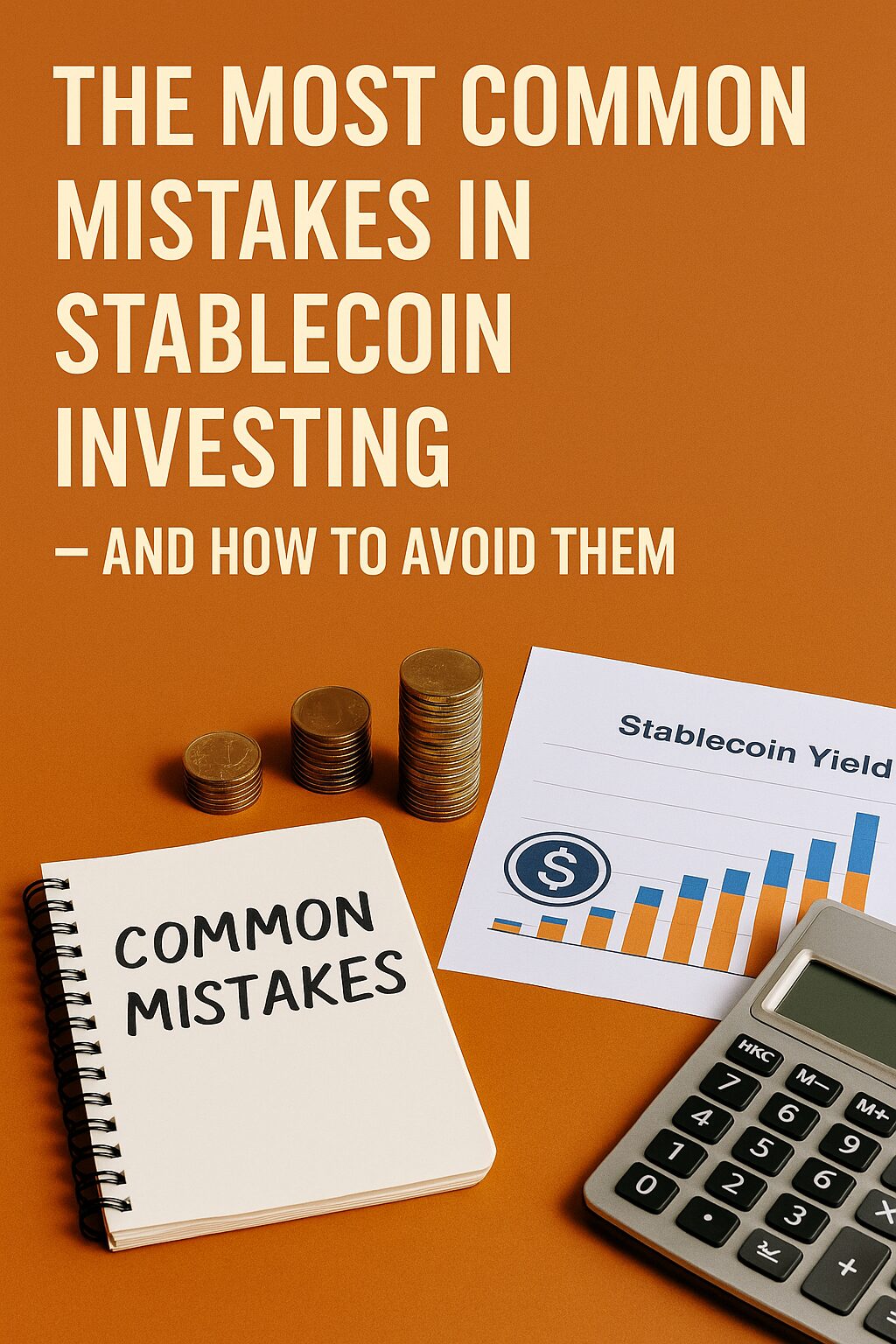Stablecoins can be powerful — or dangerous. It depends on how you use them.
Don’t Let Simplicity Fool You
Stablecoins look simple.
They’re pegged to a currency, don’t fluctuate like Bitcoin, and can earn interest passively.
But that simplicity hides real risks — not in the coin itself, but in how people use them.
Most stablecoin investors don’t lose money because of crashes.
They lose it because they make avoidable mistakes.
In this guide, we’ll break down:
- The top mistakes beginners and even advanced users make
- Why they happen
- And how to protect your capital with smart, simple fixes
Let’s get into it.
Mistake #1: Chasing the Highest APY Without Understanding the Risk
Some platforms offer 15%, even 20% yield on stablecoins. Tempting? Yes.
Sustainable? Rarely.
What happens:
- Users deposit into unknown protocols or shady CeFi platforms
- Yield dries up or the platform collapses
- Funds get locked or vanish without recourse
Solution:
- Stick to yield below 10% unless you fully understand the model
- Use platforms with audits, insurance, or regulatory licenses
- Remember: If it sounds too good to be true, it usually is
Mistake #2: Keeping All Funds in One Platform
Even top platforms can fail. Celsius, Voyager, BlockFi — all once trusted.
Then they went bankrupt.
What happens:
- You lose access to your entire balance
- No withdrawal, no exit, sometimes for months
- Legal claims may return only a fraction
Solution:
- Spread funds across multiple platforms (e.g., Nexo + Aave)
- Keep 20–30% in cold wallet for emergencies
- Set withdrawal schedules (monthly or quarterly) to reduce platform dependency
Mistake #3: Using Unstable or Poorly Backed Stablecoins
Not all stablecoins are equal. Some lose their peg.
Examples: USDN, IRON, UST.
What happens:
- Coin drops from $1 to $0.80 or worse
- Your principal evaporates even with yield
- Panic makes it hard to exit
Solution:
- Use battle-tested stablecoins: USDC, DAI, GUSD, TUSD
- Avoid coins with complex algorithmic or synthetic models
- Monitor peg performance over time before committing
Mistake #4: Ignoring Tax Implications
Many stablecoin investors assume passive yield is tax-free.
In most countries, it’s not.
What happens:
- You earn yield for months or years
- Tax authorities detect activity via exchange reporting
- You face audits, penalties, or back-taxes
Solution:
- Use tax tracking tools (Koinly, CoinTracker)
- Report yield as income where required
- Talk to a crypto-savvy tax advisor
Mistake #5: Overlooking Smart Contract Risk in DeFi
Just because it’s decentralized doesn’t mean it’s safe.
Even audited protocols like Curve and Compound have had issues.
What happens:
- Protocol gets exploited
- You lose staked assets or unclaimed rewards
- There’s no customer support
Solution:
- Stick to blue-chip DeFi protocols with large TVL and community trust
- Use hardware wallets for DeFi interactions
- Avoid new platforms unless you’re an expert
Mistake #6: Thinking Stablecoins Are Risk-Free
Just because the value doesn’t swing doesn’t mean the asset is risk-free.
Risks include:
- Regulatory crackdowns
- Platform insolvency
- Peg instability
- Censorship or blacklisting of your wallet
Solution:
- Treat stablecoins like real money: manage it actively
- Use non-custodial wallets where possible
- Stay updated with regulatory changes in your country
Mistake #7: Blind Trust in “Audited” or “Licensed” Claims
Some platforms advertise audits or registrations that mean very little.
What happens:
- Users assume safety without verifying
- Audits may be outdated or non-public
- “Registered” may just mean a basic business license
Solution:
- Read audit reports, not just badges
- Check regulator databases (e.g., FCA, SEC, BaFin)
- Look for third-party reviews, transparency dashboards, real team identity
Mistake #8: No Exit Strategy
Earning yield is great.
But what’s your plan if:
- You need cash urgently?
- The platform halts withdrawals?
- A better opportunity arises?
What happens:
- You’re stuck
- Forced to exit at a bad time
- Lose yield or even capital
Solution:
- Set pre-planned exit triggers (e.g., yield drops, regulatory warnings)
- Keep part of your portfolio liquid
- Review your plan every 6 months
Summary: The 8 Most Common Mistakes
| Mistake | Risk | Solution |
|---|---|---|
| Chasing high APY | Capital loss | Use trusted platforms, aim <10% |
| Single-platform exposure | Total lockup | Diversify across 2–3 providers |
| Bad stablecoin choice | Peg failure | Stick to trusted coins |
| Tax negligence | Legal issues | Track and report income |
| DeFi smart contract risk | Asset loss | Use reputable, large protocols |
| Believing it’s risk-free | Hidden threats | Active management |
| Blind audit/license trust | False security | Verify thoroughly |
| No exit plan | Loss during emergencies | Plan exits and review often |
Final Thoughts: Smart Money Wins, Greedy Money Loses
Stablecoins can offer steady income, flexibility, and control —
But only if you avoid the traps that hurt most investors.
Don’t aim to double your money overnight.
Aim to keep your money safe, working, and compounding forever.
Smart stablecoin investing means:
- Discipline
- Diversification
- Due diligence
Avoid these mistakes — and your stablecoins may become your strongest financial asset.
📌 Coming Up Next
Why Decentralized Stablecoins Might Be the Future — and What You Should Know Now
→ In our next post, we’ll explore how decentralized stablecoins like DAI and LUSD could reshape the way we think about money — and how you can get ahead of the trend safely.
